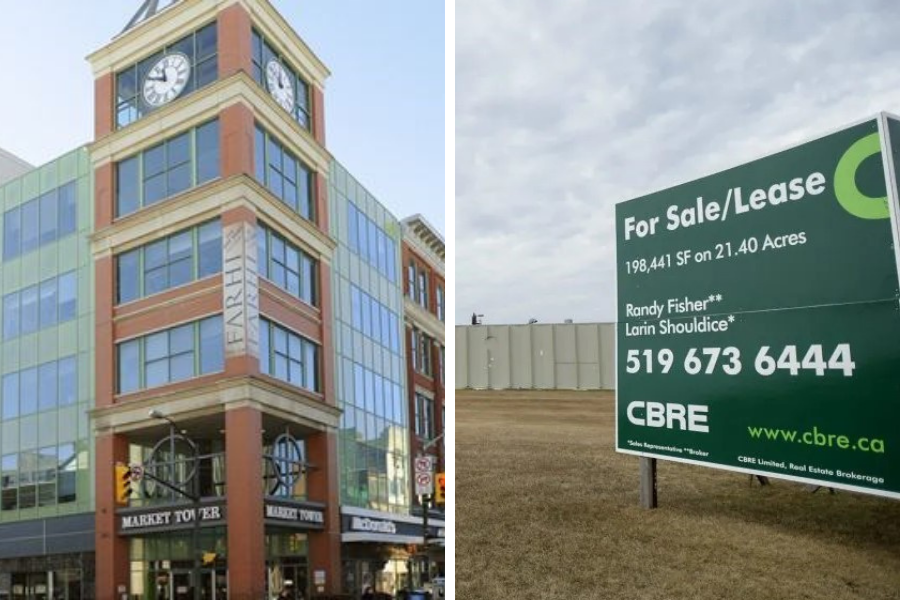Two very different problems
Commercial real estate Q3: Concerns deepen for the city’s downtown office market while supply shortages on the industrial side continue to hamper growth
WHEN IT COMES to London’s commercial real estate market, it continues to be a tale of two worlds.
Concerns and questions abound for London’s office real estate market, particularly for the downtown.
According to the recently released CBRE Canada Quarterly Statistics Report for Q3, the London office market observed waning demand throughout the quarter. Increased vacancy is being felt across the city and all product types, with the core most severely impacted, with vacancy reaching 19.3 per cent.
“Downtown, the elephant in the room is the social problems, which were an issue going in [to the pandemic]. Attracting employees into the core has proven challenging for employers” ―Ted Overbaugh
Ted Overbaugh, senior VP and managing director on CBRE’s Ontario team, told London Inc. that with many businesses remaining in a wait-and-see mode regarding future work models, questions about office space in the core are near impossible to answer.
“It’s the question of the day on the office market: where are we trending and where do we go from here?” says Overbaugh. “I think the whole dynamic of the office market is still going to play out ― and play out over the next couple years. A lot of people are still trying to figure out who comes back and who can be flexible. It’s still a work in progress.”
On the suburban office side, the market also experienced a vacancy increase of 60 bps to 7.2 per cent, but this remains below the five-year average of 10.6 per cent and its pre-pandemic Q1 2020 vacancy rate of 10.2 per cent.
Story Continues Below
“For London, it’s almost like a tale of two markets — it’s the suburbs and it’s downtown. The suburbs are performing well — there’s amenities, there’s free parking. Downtown, the elephant in the room is the social problems, which were an issue going in [to the pandemic]. We’ve got some fairly significant issues in the core. Attracting employees into the core has proven challenging for employers.”
In addition to those social issues, with the pandemic accelerating trends like the adoption of digital business solutions and work-from-home policies, it is leading many companies to experiment with reducing their physical footprint as their leases come up for renewal.
And on top of that, with many Canadian municipalities charging commercial tax rates of two to four percentage points higher than residential tax rates, revenue shortfalls are quickly becoming an ongoing municipal reality because of the commercial real estate decline in downtown areas.
 CBRE’s Ted Overbaugh
CBRE’s Ted Overbaugh
Lump all of those factors together, and many industry observers believe it is time to start looking at ways of repurposing and refinancing core-area commercial buildings for different uses.
“I do think that’s something we’re going to have to give a good hard look to,” says Overbaugh. “We’re going to need to put our collective heads together. Is it new uses, is it residential? There’s going to be shakeups in the office market for sure, and I think there’s more fallout to come as vacancies continue to trend upward in the near-term. Downtown London is a perfect example of that.”
London’s Industrial Market
Looking at the city’s industrial real estate market, it’s a problem of a completely different sort as strong demand continues to outpace new supply, with virtually no available real estate to satisfy it.
And further underscoring the current supply shortage, market activity in Q3 saw net absorption equal 55.7 per cent of the now remaining available space. As a result, the availability rate decreased 30 bps to 0.9 per cent, meanwhile vacancy remained unchanged at 0.8 per cent.
“It is a problem,” says Overbaugh. “We’re facing a real shortage of available space. When you look at London, there’s very little speculative development. It’s probably going to prohibit some growth that we’d like to see.”
“Compared to trying to buy land in neighbouring municipalities such as Brantford and Waterloo, London is still cheap” ―Ted Overbaugh
With virtually no available space, average net asking rental rates on the industrial side continue to climb, escalating 26.1 per cent year-over-year to the current rate of $7.16 per square foot. Likewise, average sale prices have faced similar upward pressure and increased by 84.8 per cent over the same timeframe to $120.28 per square foot.
With the squeeze, the City of London recently moved to increase the price of city-owned industrial land for the first time since 2018. Starting in November, industrial parcels under five acres will increase from $80,000 per acre to $125,000 per acre, while properties five acres or larger will rise from $70,000 per acre to $115,000 per acre.
Story Continues Below
“It’s needed and it’s probably overdue; you can easily justify it in the market,” says Overbaugh. “Compared to trying to buy land in neighbouring municipalities such as Brantford and Waterloo, London is still cheap.”
One area Overbaugh suggests is hampering industrial progress is development charges.
“I guess the one problem is just the way we run our development charges program here in London,” he notes. “Warehousing and spec developments are charged development charges [of around $19 a square foot]. You can buy land affordably, but when you factor in development charges, it’s hard to make the numbers work.” ![]() With files from Kieran Delamont
With files from Kieran Delamont

